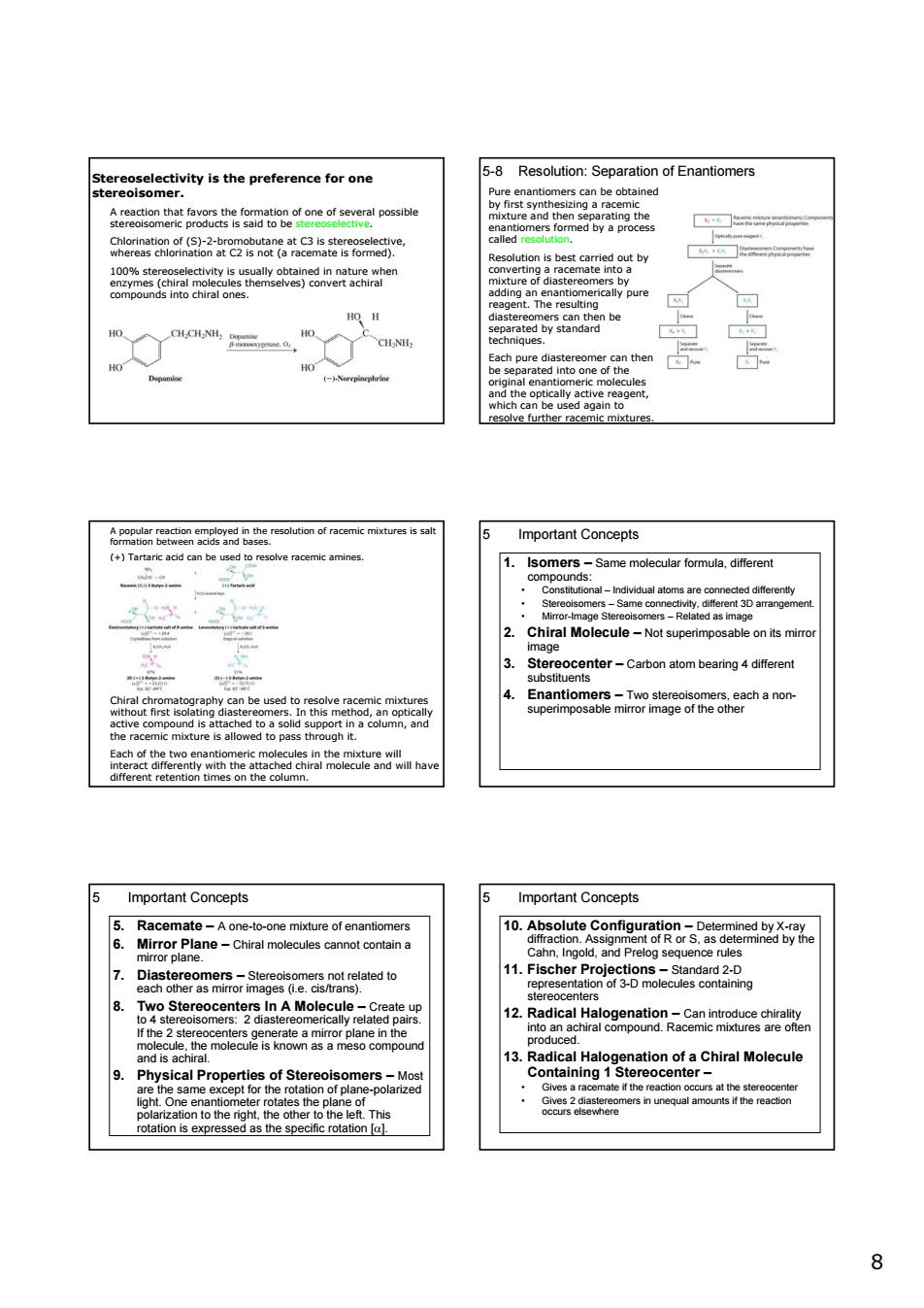正在加载图片...

stereoselectivity is the preference for one 5-8 Resolution:Separation of Enantiomers e 5 Important Concepts (+Tar cld can be us ve racemk amines 2. MolculeNot 3 be usec Enantiomeigemesaehanon 5 Important Concepts Important Concepts aeRe 1 Two Stereocenters In A Molecule-Create up 12.Radical 13.Radical Hal 8 8 Stereoselectivity is the preference for one stereoisomer. A reaction that favors the formation of one of several possible stereoisomeric products is said to be stereoselective. Chlorination of (S)-2-bromobutane at C3 is stereoselective, whereas chlorination at C2 is not (a racemate is formed). 100% stereoselectivity is usually obtained in nature when enzymes (chiral molecules themselves) convert achiral compounds into chiral ones. 5-8 Resolution: Separation of Enantiomers Pure enantiomers can be obtained by first synthesizing a racemic mixture and then separating the enantiomers formed by a process called resolution. Resolution is best carried out by converting a racemate into a mixture of diastereomers by adding an enantiomerically pure reagent. The resulting diastereomers can then be separated by standard techniques. Each pure diastereomer can then be separated into one of the original enantiomeric molecules and the optically active reagent, which can be used again to resolve further racemic mixtures. A popular reaction employed in the resolution of racemic mixtures is salt formation between acids and bases. (+) Tartaric acid can be used to resolve racemic amines. Chiral chromatography can be used to resolve racemic mixtures without first isolating diastereomers. In this method, an optically active compound is attached to a solid support in a column, and the racemic mixture is allowed to pass through it. Each of the two enantiomeric molecules in the mixture will interact differently with the attached chiral molecule and will have different retention times on the column. 5 Important Concepts 1. Isomers – Same molecular formula, different compounds: • Constitutional – Individual atoms are connected differently • Stereoisomers – Same connectivity, different 3D arrangement. • Mirror-Image Stereoisomers – Related as image 2. Chiral Molecule – Not superimposable on its mirror image 3. Stereocenter – Carbon atom bearing 4 different substituents 4. Enantiomers – Two stereoisomers, each a nonsuperimposable mirror image of the other 5 Important Concepts 5. Racemate – A one-to-one mixture of enantiomers 6. Mirror Plane – Chiral molecules cannot contain a mirror plane. 7. Diastereomers – Stereoisomers not related to each other as mirror images (i.e. cis/trans). 8. Two Stereocenters In A Molecule – Create up to 4 stereoisomers: 2 diastereomerically related pairs. If the 2 stereocenters generate a mirror plane in the molecule, the molecule is known as a meso compound and is achiral. 9. Physical Properties of Stereoisomers – Most are the same except for the rotation of plane-polarized light. One enantiometer rotates the plane of polarization to the right, the other to the left. This rotation is expressed as the specific rotation [α]. 5 Important Concepts 10. Absolute Configuration – Determined by X-ray diffraction. Assignment of R or S, as determined by the Cahn, Ingold, and Prelog sequence rules 11. Fischer Projections – Standard 2-D representation of 3-D molecules containing stereocenters 12. Radical Halogenation – Can introduce chirality into an achiral compound. Racemic mixtures are often produced. 13. Radical Halogenation of a Chiral Molecule Containing 1 Stereocenter – • Gives a racemate if the reaction occurs at the stereocenter • Gives 2 diastereomers in unequal amounts if the reaction occurs elsewhere